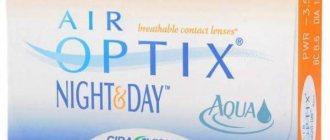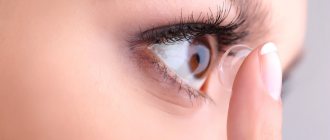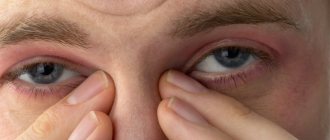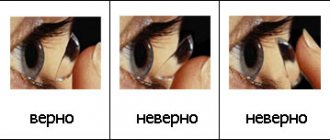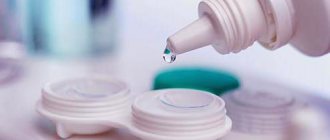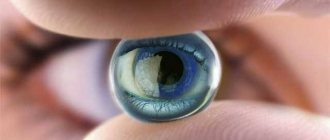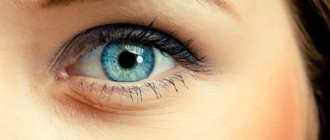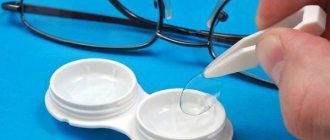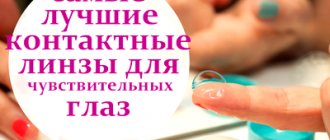What you need to know about lenses
Contact lenses are a modern means of vision correction. With their help, the main refractive errors - myopia (myopia), hyperopia (farsightedness), presbyopia (age-related farsightedness) and astigmatism - are effectively corrected. Externally, contact lenses are a transparent thin film, the back surface of which completely follows the shape of the cornea, and the front surface corrects vision.
The modern ophthalmological market offers a huge variety of contact lenses. First of all, daily contact lenses are classified into two large groups:
- hard;
- soft.
Soft contact lenses are the most common option for contact vision correction among consumers. They consist of 35-80% water, which gives them flexibility, softness and high oxygen permeability. There are no blood vessels in the cornea of the eye, and it receives oxygen directly from the air. The selection of lenses is very important, so the contact lens material must allow sufficient oxygen to pass through to the cornea.
The higher the oxygen permeability of soft lenses, the better for eye health.
Depending on the material and manufacturing technology of contact lenses, their wearing mode, service life, as well as rules for caring for them may vary. Soft contact lenses are typically made from two types of materials:
- Hydrogel. This is a polymer material that is soft when in contact with water and has good wettability. These material properties provide comfort while wearing and eliminate the feeling of a foreign body in the eye. Lenses made from hydrogel can have low or high hydration capacity (water content). Hydrogel lenses with low water content (38-45%) have low oxygen permeability, so they should not be worn for more than 12-14 hours. The disadvantages of hydrogel lenses are low strength and susceptibility to germination by microorganisms.
- Silicone hydrogel. This is an innovative material that began to be used for the manufacture of contact lenses relatively recently. Some silicone content in these contact lenses makes them harder and more durable. In addition, the silicone hydrogel material is more oxygen permeable and does not dry out while wearing.
To give the desired shade to the eyes, special colored contact lenses are used. They are especially popular among young people. You can also correct your vision with tinted contact lenses.
Who are contact lenses recommended for?
The choice of lenses depends primarily on medical indications. Before purchasing ophthalmic products, you need to be examined by a doctor. The specialist will determine the basic parameters that contact lenses must meet. Patients can resort to the use of contact optics:
- with myopia;
- with farsightedness;
- with astigmatism (as well as when the disease is combined with myopia and farsightedness);
- with hypermetropia;
- with keratoconus;
- with age-related changes;
- with a violation of the shape of the cornea or lens.
The patient's diagnosis must be confirmed by an ophthalmologist. Under no circumstances should you make your own diagnosis and choose optics. Now let's look at what types of contact lenses there are.
Specifics of wearing mode
Soft contact lenses have different periods and modes of wearing, which are usually indicated on the product packaging. These rules established by the manufacturer must be strictly adhered to. Ophthalmologists do not recommend exceeding the period of wearing contact lenses, as this is fraught with dangerous complications, which in advanced cases can lead to deterioration of eye health and even rapid loss of vision.
Soft contact lenses are divided into three groups according to wear time:
- Traditional contact lenses. These are the earliest soft contact lenses and appeared before other types. These are long-term wear lenses. Their wearing period is about 0.5 - 1 year. The cost of these lenses is low, but they require careful care. In modern times, the popularity of traditional contact lenses is rapidly declining.
- Scheduled replacement contact lenses. These contact lenses are more in demand in the market than their traditional counterparts due to their countless benefits. The period of wearing planned replacement lenses can be different - 2 weeks, a month, a quarter. These lenses are made from various materials and may have different water content and oxygen permeability. When purchasing these lenses, you need to pay special attention to these indicators.
- Daily contact lenses. The most expensive, but safest type of soft contact lenses. Ideal for those who do not want to constantly care for their lenses. However, not everyone can afford this. Daily contact lenses are very convenient for trips, business trips, and traveling, since you do not need to take a container and care products with you. After removal, these lenses are disposed of and new ones are put on the next day.
Contact lenses made from hydrogel can be safely worn for about 8-12 hours. In no case should you wear them for more than 15 hours, much less sleep in them, since in this case there is a high risk of developing corneal hypoxia.
Silicone hydrogel lenses can be worn even while sleeping if they have a high oxygen permeability rate. Today, on the contact vision correction market, you can purchase extended-wear lenses that can be left in place for 6, 14, or even 30 days.
Daily contact lenses
Types of contact lenses
The modern ophthalmological market offers a large number of contact lenses not only to improve vision, but also decorative ones designed to change eye color. This type can also be with diopters and is intended to correct vision. Lens manufacturing technologies have come a long way. Today, contact optics manufacturers use completely safe materials for their production. By type of material, products are divided into:
- soft;
- hard.
There are also several types of lenses depending on the replacement period.
Tips for caring for lenses
Proper care of contact lenses will not only allow you to maintain eye health and comfort while wearing, but will also extend the life of the product. If you do not want your lenses to deteriorate ahead of schedule, you need to care for them correctly. Typically, care is required for traditional lenses and routine replacement lenses. Daily lenses require no maintenance.
Daily cleansing
Before any manipulation with contact lenses, the main condition must be fulfilled - maintain hand hygiene. Hands must be washed thoroughly with soap and running water. It is advisable to use antibacterial soap (without various fragrances and chemical impurities).
To clean multi-day contact lenses, you need to purchase a multi-purpose solution, a storage container and tweezers for removing lenses. Contact lenses should be cleaned daily immediately after removal. Cleaning is carried out using a universal, multi-purpose solution.
Daily cleaning of lenses is carried out as follows:
- Place the contact lens on your palm.
- Place a few drops of universal solution on the inner surface of the lens.
- Wipe the inside and outside of the lens with your fingertips.
- Pour a small amount of fresh solution into a clean container and place the contact lenses in it.
To prevent infection from getting into your eyes, you need to take care not only of the cleanliness of your contact lenses, but also of the cleanliness of the container. After putting on contact lenses in the morning, the solution should be poured out of the container, rinsed with clean running water and left to dry in a well-ventilated area with low humidity.
Soft contact lenses must be treated with products designed to care for soft contact lenses. In no case should you treat them with solutions and products for hard contact lenses, as their shape can be deformed and the lenses will quickly become unusable.
If your eyes are prone to dryness, then it is advisable for you to purchase lens solutions with a special moisturizing component. Also, you should additionally purchase drops to moisturize your eyes. It is not recommended to instill eyes with a universal solution, as this can lead to irritation and inflammation of the mucous membrane of the eye.
Enzymatic purification
It is known that hydrogel or newer and more modern silicone hydrogel material is used for the production of contact lenses. This material has a porous structure, and its pores are regularly clogged with particles of dirt, dust, as well as protein and lipid deposits of the eye. These contaminants form an opaque film on the surface of the lenses and then negatively affect the quality of vision correction. To clean contact lenses from these contaminants, enzyme cleaning is performed. It is especially necessary for cleaning contact lenses worn for more than three months. Cleaning should be done once a week.
To find out how to choose long-wear lenses, follow the link.
Enzyme tablets are used to remove protein deposits from contact lenses. They effectively break down various organic compounds and remove them from the porous structure of contact lenses. Thus, the surface of the lenses becomes completely transparent after cleaning.
If you do not regularly clean contact lenses from protein deposits using enzyme tablets, microorganisms begin to rapidly multiply in them, which leads to unpleasant consequences in the form of inflammatory eye diseases, burning and stinging in the eyes, a feeling of a “veil” before the eyes and discomfort when wearing contact lenses. lenses Enzymatic cleaning is necessary primarily for traditional lenses and routine replacement lenses.
Enzymatic cleaning of contact lenses is carried out as follows:
- To carry out the procedure, you need to prepare several tablets, tweezers and a container. Before cleaning, wash your hands thoroughly with soap and water.
- The container in which the cleaning will be carried out must be rinsed with water and filled with fresh multi-purpose solution. Instead of a cleaning solution, you can also use hydrogen peroxide or saline solution.
- Remove the enzyme tablets from the packaging and use tweezers to immerse them in the container with the solution until completely dissolved.
- Place the contact lenses in the container for a certain time (this time may vary, and it is usually indicated by the manufacturer on the product packaging). The container must be closed during cleaning.
- After cleaning, contact lenses and the container should be washed with water. After the procedure, the lenses must sit in a container with a multi-purpose solution for about 2 hours before they can be worn.
It is not recommended to exceed the cleaning time for contact lenses, as this can damage them and then cause discomfort while wearing them.
A hydrogel material with a high percentage of water content tends to absorb more protein and lipid deposits. However, hydrogel lenses with high hydration capacity cannot be subjected to enzymatic cleaning for a long time, since particles of these substances often remain in the lens and then cause eye irritation during wear. The incompatibility of these lenses with enzymatic cleaners significantly reduces their service life.
Extended wear contact lenses can be worn continuously for a certain period of time. However, it is recommended to remove them at night at least once a week to ensure complete cleaning and disinfection. Due to the 24/7 wearing of these lenses, there is a huge risk of infectious eye diseases.
Read about choosing lenses for your eyes here.
Disinfection
Disinfection of contact lenses is a mandatory procedure to ensure the safety of your eyes and protect them from the development of inflammatory diseases.
Most often, chemical disinfection is carried out using specific disinfectants (for example, benzalkonium chloride, chlorhexidine, polyquad, dimed).
To effectively sterilize contact lenses, as well as to remove various deposits and preservatives from the surface of lenses, a peroxide system is often used. It is especially advisable to use it for contact lenses worn for more than one month. Contact lenses are cleaned using a peroxide system once every 1-2 weeks.
The main component of the peroxide system is a three percent solution of hydrogen peroxide, which can effectively destroy a wide range of bacteria, viruses and fungi. In addition, the peroxide system does not contain various preservatives, so it is well suited for people with sensitive eyes and those suffering from allergic reactions to certain components of cleaning solutions. The peroxide system should not be used to disinfect soft contact lenses with high moisture content as this may cause significant damage to them.
When using the peroxide system, all rules must be carefully followed. It is imperative to wait until the hydrogen peroxide is neutralized and not remove the lens from the solution ahead of time. The peroxide particles can then get into the eye and cause burning and other discomfort.
Heat treatment is also used to disinfect lenses. It is carried out in a water bath for 20 minutes. However, this disinfection method is not recommended, since regular heating leads to rapid wear of the material from which the lenses are made, as well as a change in their optical properties. Such disinfection can be carried out only for lenses with low hydrophilicity and only for patients with allergic reactions to the components of cleaning solutions.
Read about how to care for soft contact lenses.
Storage
Containers and tweezers
It is not recommended to keep soft contact lenses outdoors for long periods of time. Evaporation of water, which is present in their composition, in large quantities, will lead to drying and deformation of the material. It will no longer be possible to wear such lenses. A special container with solution is intended for storing lenses. The container is necessary to prevent the material from which the lenses are made from drying out and becoming saturated with moisture.
The container must always be kept sterile. After use, the solution must be poured out and a new one poured in. After pouring the solution, the container must be treated with a disinfectant and dried.
The container must be changed monthly. It is recommended to do the same with tweezers to remove lenses from the container.
How to care for colored contact lenses?
Particular attention should be paid to the rules for caring for colored lenses. They are slightly different from the rules for caring for regular clear contact lenses.
Since colored contact lenses have a layer of pigment, they must be cared for very carefully. To care for colored contact lenses, special non-aggressive products are required that will not damage the pigment layer. This is especially true for disinfection. Peroxide solutions should not be used to sterilize colored lenses.
Read more about tint lenses here.
Lifespan of contact lenses
Daily replacement models are discarded after a full day of wear. They are convenient because they do not require maintenance. For such products there is no need to purchase related products, but at the same time they are more expensive than traditional ones. It is recommended to wear these products for no more than 12 hours at a time. Frequently scheduled replacement models have a service life of one to two weeks or a month. This type is one of the most optimal options in terms of cost and ease of use. Planned replacement models have a wear period of one month, 3 months or six months. These lenses cannot be worn without removing for more than a day. It is not recommended to use them for more than 15 hours at a time. The most economical option presented in the line of modern optical products are traditional replacement lenses. One pair is purchased for a period of six to 12 months. They can only be worn during the day; such lenses must be removed before going to bed. Traditional replacement models are sold in glass containers only. They are thick, which makes them the most durable. The period of operation of contact products is established by the manufacturer. This information is contained on the packaging. After the established period, wearing optical products is prohibited.
Consequences that arise from improper care
Following all the rules and nuances for lens care will allow you to avoid many eye problems. These can be various complications caused by neglecting the rules of hygiene and wearing contact lenses.
If you do not clean your lenses daily or do not disinfect them at the proper time, there is a huge risk of inflammatory eye diseases. These include conjunctivitis, keratitis, blepharitis and other diseases.
Without proper cleaning of contact lenses from dirt and protein deposits, the transparency of the lens decreases and, consequently, the quality of vision correction deteriorates. In addition, protein deposits clog the pores of the material, which leads to a decrease in the oxygen permeability of the lenses and the development of corneal hypoxia due to insufficient oxygen supply.
Wet cleaningCONTENTS
Another option to get rid of stains and small dots is wet cleaning: wipe the lens with a chamois or microfiber cloth soaked in distilled water, or isopropyl alcohol (99.7%), or pure ethyl/methyl alcohol (96%). Before use, do not forget to wash any napkin with soap, wring it out, and dry it.
Photo 18. Wet microfiber in action
To remove dandruff and micro-dust particles, distilled water is enough (sold for 40 rubles per 2 liters in Auto Parts stores or in Auchan in the “everything for cars” department):
Photo 19. Distillate
Alcohol is used as a solvent for grease and oil stains. Isopropyl alcohol (isopropanol) is used because it is extremely pure (up to 99.998%), so it can dissolve more and, as it evaporates, carries everything dissolved with it into the air:
Photo 20. Click on this photo (will open larger in a new tab) to read on the label why this wonderful alcohol is needed
Because pure alcohol evaporates too quickly, and we need a longer-lasting wet napkin, it makes sense to dilute it with distilled water (for example, to the state of vodka - 40% alcohol, 60% water; you cannot use store-bought drinking vodka - it contains sugar and some other nasty stuff mixed).
In one of the How It's Made episodes they show how lenses are made (I think the Carl Zeiss plant is shown there). Before gluing lenses or installing them in a lens, they are washed manually in exactly this way: a thick microfiber swab is moistened in a secret liquid (it says “acetone” on the bottle) and rubbed over the lens, which is held in the other hand (all fingers are covered with rubber fingertips).
Related items for the care and storage of contact lenses
For people who have visual impairments, contact lenses become an integral part of everyday life. Constant care of contact optics will require the purchase of related products. The most necessary of them include:
- container for ophthalmic products;
- liquid for lenses.
To make care simple and easy, modern manufacturers offer a wide variety of products. Among them are tweezers, a stick with a suction cup, mini-containers for solution, and a case with a mirror. Today, all these items are sold both individually and in sets. Cases with different numbers of items have a wide variety of designs. Sets can contain from three to five items. This way, everything you need to remove, put on and clean your lenses will always be at hand. Thanks to this, you can always ensure proper care of your optical products. As a rule, cases with different numbers of items have a mirror. Its presence will facilitate the process of removing and putting on contact optics. There are a huge number of such sets of different designs. The choice will depend only on your personal preferences. It is very convenient to use such sets when traveling, on the road, or on a business trip.
MagazinLinz.ru Team
Tags: Opti-Free ReNu Accessories Solutions Articles
